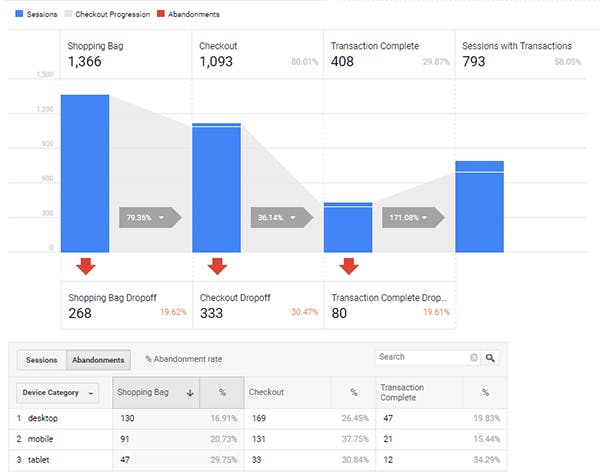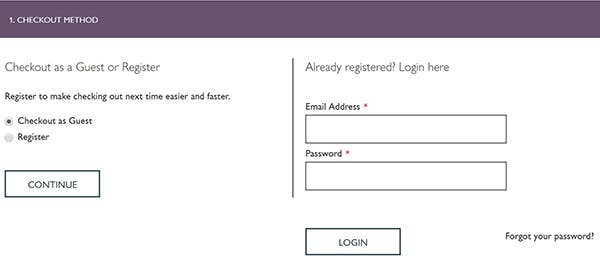6 Ways to Reduce Cart Abandonment

According to Baymard Institute, the average rate of shopping cart abandonment is a staggering 68%! This means that the majority of shoppers who add products to their cart will end up leaving a website without making a purchase. There are a variety of reasons for this, from high shipping costs to customers simply getting distracted while shopping. Luckily, there are ways to combat each of these issues. We’ve rounded up some of the best solutions to help you avoid losing too many potential sales.
Use Analytics
Rather than making assumptions about why visitors aren’t completing their transactions, you can get a better idea by using Google Analytics. One report that can help with this is Funnel Visualisation, found in the Conversions section. This indicates the dropout rate from each step of the checkout process. If a high number of exits are made on a particular part of the process then it can help you understand what changes could be made to improve conversions. For example, if the form section has a high dropout rate, you may want to consider whether you should reduce the length of the form.
Another report which can give you insight into the checkout process is Checkout Behaviour (select Conversions>Ecommerce). Once you’ve carried out the initial setup, you’ll be able to see the number of sessions for each stage of the of checkout process, as well as the dropoff rates. Below this graph you can see a table that compares the checkout stages between new and returning visitors. To dig deeper, you can segment your results such as by location or the device used. The latter is a great way to highlight technical issues or poor page layouts on particular devices such as mobiles.

Cart abandonment isn’t necessarily all down to the checkout process however, so you should also look into shopping behaviour across the rest of your site. Look at the Behaviour Flow and the Shopping Behaviour Analysis to discover which areas of your website have a high number of exits and how users navigate through your site. This can help you understand which areas to focus on improving the user’s shopping experience.
Be Clear About Costs Upfront
The number 1 reason why customers don’t complete their order during checkout is because of unexpected additional costs. Whether it’s for shipping, VAT or booking fees, shoppers can find it frustrating when they are hit with extra costs at the final steps of the checkout process. Instead, it’s better to be transparent about costs while visitors are browsing through your products. This could be via a banner, a shipping calculator, or a clear link to the shipping page from each product page.
Unfortunately, many online shoppers can still be put off by shipping fees even if they’ve been warned! You could counteract this by offering free shipping or discounts based on the total cost of orders eg. Save 10% on orders £75+
Offer a Guest Checkout Option
Another cause of shopping cart abandonment is that users find out they’re required to set up an account to make a purchase. They may not have the time for this or find it a hassle, so including a guest checkout option is an ideal solution. Although customer accounts are great for gathering data, it’s more important that you encourage shoppers to complete their purchase. Plus, the easier you make their shopping experience, the more chance there will be of them returning to your website. Not only that, but they may want to create an account in the future to take advantage of incentives like loyalty programs.
Send Abandoned Cart Emails
According to dotdigital, an abandoned cart email has a higher chance of being opened and getting a customer to make a purchase compared to other marketing emails they receive. It’s therefore a no-brainer that automated abandoned cart emails should be set up. It’s best to create a series of emails to help remind and encourage the customer to buy what they left in their basket. Many people can get distracted when they’re shopping online, so the first email should act as a gentle nudge. As mentioned previously, some shoppers don’t complete their orders due to shipping fees. This is why it’s a good idea to include a shipping discount code for the final email. Ideally, the first email should be sent within the hour after abandonment, the next 1 or 2 days later and the third one should be 3 or 4 days later.

Make sure you include images at the top of the email of the items they left in their cart. It’s also essential that you add a call-to-action to complete the transaction. When it comes to the subject line, try to include the name of the product or category.
Include Social Proof
With so many brands and products to choose from online, the buyer’s decision making process can be a long one! Many shoppers will be comparing your products with your competitors’ while browsing, so it can take a bit of persuasion to get them to choose your products. An effective way to do this is by adding social proof to your website. This can be done by featuring reviews on your product pages. Customers are much more likely to feel confident in what they’re spending their money on if they see that others are happy with the product. Also, if your products have a range of benefits, it’s a great idea to feature testimonials on your website.
Increase Trust
When customers are making an online purchase, they need to be able to trust that their personal information and payment details are secure. One of the most important ways to do this is by having a valid SSL certificate. If a website doesn’t have one, or it’s expired, visitors will see a warning message in their browser that the connection may not be secure. It’s unlikely that people would want to give their payment details away when they’ve been informed of this risk.
Many consumers look for trust symbols before making a purchase. Include well-known security logos, such as Verified by Visa or Paypal Verified, somewhere near your transaction forms. This can help reassure customers that they don’t need to worry about submitting their credit card information.

To sum up, there are various reasons why people add items to their cart and don’t end up buying them. Many are related to user experience, so it’s important that you identify the key areas that need to be improved. Google Analytics is the best starting point so you can make informed decisions. One solution that applies to every ecommerce business is to send abandoned cart emails, as sometimes shoppers just need a reminder.
Let us know how you get on with reducing your cart abandonment rate, or if you need help defining and implementing a strategy.
References:



